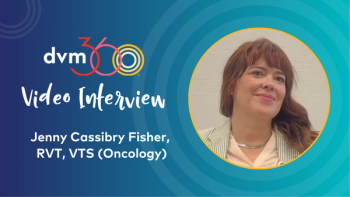
Who's responsible for drumming up business?
As a management consultant, Dr. Karen Felsted is no stranger to controversy. Yet, even she was surprised by the emotion owners and associates showed during a discussion about the role associates should play in attracting clients. Dr. Felsted, CPA, MS, CVPM, was one of four moderators for the session, which took place during the Central Veterinary Conference last August.
By John Lofflin, Special Assignments Editor
As a management consultant, Dr. Karen Felsted is no stranger to controversy. Yet, even she was surprised by the emotion owners and associates showed during a discussion about the role associates should play in attracting clients. Dr. Felsted, CPA, MS, CVPM, was one of four moderators for the session, which took place during the Central Veterinary Conference last August.
Owners saw client recruitment as part of associates jobs, says Dr. Felsted, a Veterinary Economics Editorial Advisory Board member and a consultant with Brakke Consulting Inc. in Dallas. But associates said, I show up and you should provide the clients. It was the usual owner/employee disconnect, but the doctors showed particular vehemence.
Given the emotions involved, expectations about attracting clients may be a factor in the associate merry-go-round so often lamented in todays practices. In fact, nearly half of the owners who responded to the 2003 Veterinary Economics Client Development Study reported keeping associates for less than three years, and only one in three associates reported spending more than five years in a practice.
The disagreement over attracting new clients is exacerbated by yet another disconnect: Owners hire associates before the practice is ready, but associates dont realize theyll need to build a client base to pay their own way.
What owners say
The Veterinary Economics study, which reports responses from 279 doctors, explores the business issues behind the emotions. The editors opened the discussion by simply asking, What can an owner reasonably expect an associate to do to attract clients?
Some owners kept their responses simple and focused on medicine with such responses as: Bring a fresh point of view to an established practice and Provide high-quality medicine and service. However of the 131 owners responding, 43or one-thirdexpected associates to be involved in community activities to attract clients. Associates responses were similar, but focused more on providing good care and service and less on community involvement, with only one-fifth mentioning participation in local organizations.
Between the two groups, the respondents compiled an impressive list of options for community outreach, including encouraging friends and relatives to visit the practice, handing out business cards, speaking at pet-related events, and joining a wide range of community organizations. Their suggestions: church, Rotary International, Junior Chamber of Commerce, Chamber of Commerce, Lions International, Kiwanis International, Elks of the USA, 4-H, Boy Scouts of America, Girl Scouts of the USA, high-school groups, hunting clubs, local humane societies, and kennel clubs. Respondents also suggested working with local radio shows, writing a newspaper column, and coaching soccer and baseball teams. Whew!
One owner suggested: Always keep a pocketful of business cards, attend local social and pet-oriented events, and be active in the community. Another suggested: Get involved in the community by volunteering to speak at schools, community colleges, and so on. Offer to extend regular office hours and see evening appointments. Offer to work occasional shifts at a local animal ER.
One owners solution
Advisory Board member Dr. Dennis Cloud says that a new associate in his 33-year-old St. Louis, Mo., practice recently told him that six or seven of the veterinarians she graduated with the previous spring had already left their first practices. He thinks one reason for high turnover among new associates is difficulty building their own client base, and hes trying to do something about it in his two clinics.
His strategy is based on an observation made in his practice: Seasoned veterinarians are consistently booked solid on Saturdays with wellness cases, often seeing a parade of clients whose pets theyve treated for two decades. Of the 13,000 clients in his practice, who does that leave for the new associate?
It leaves emergencies, he says. It leaves new clients who were unhappy with their previous veterinarians. It leaves clients who have been to two or three other practices looking for second opinions. It leaves difficult clients and difficult pets.
Every practice has a Nasty Bombasty, he says with a chuckle. The dogs meaner than sin and so is the owner. The receptionists know not to book Nasty Bombasty with Dr. Cloud. So, who gets Nasty on Saturday afternoon?
These scenarios, Dr. Cloud suggests, make building a client base a tough job for the new associate. He or she is starting practice with the most difficult casesand with the clients who are least likely to bond to the veterinarian.
The first step Dr. Cloud took to address this problem is to leave six slots open every day for seasoned veterinarians to see new clients and difficult cases. The receptionist cant fill these appointments with wellness cases. Instead, she tells the well-pet owner: Dr. Cloud is booked up today. He can see you next Tuesday, or you can see Dr. Smith today.
The strategy works, he says, but has one hitch. His seasoned associates working on production sometimes complain about leaving six appointments open because theres a risk they might not see anyone. And, he admits, that issue makes this strategy a balancing act.
Dr. Cloud also recommends paying new associates a salary rather than basing their income on production. I dont want the new graduate worrying about his numbers, he says. I want him to worry about his cases.
The third step: He directs the best cases for building a client base to new associates. I really like to start puppies and kittens with the new associate, he explains. Thats a time when people really bond to a veterinarian. Youre going to see the puppy or kitten three or four times in the first year. Thats where you find the type of clients I love: the well-educated 20- or 30-something couple with no children that wants to know everything about their new puppy. Youre their pediatrician. I tell the associate this is how you can grow your practice.
Thats right: your practice. Dr. Cloud wants his new associates to think of client building as growing their own practice within his. Some owners really disagree with me on this, he says. They want the client bonded to the practice, not the veterinarian. But I want my clients bonded to their veterinarian. I go to an internist group, but Im not bonded to the group. Im bonded to Dr. Poe.
The final step in his strategy is to talk openly with new associates about his expectations. He notes that most practices have job descriptions for receptionists, veterinary technicians, kennel workers, and groomers, but not for associates. Often, he says, new associates dont even know how many clients you expect them to see. Settle that question, he says, and the process of working together for success will have a firm foundation.
What associates say
The disconnect Dr. Felsted saw at the Central Veterinary Conference, and the heat she felt, was most obvious when Veterinary Economics editors invited associates to share additional comments. One wrote: Many owners work part-time hours while their associates work full time, forego lunch breaks, and often stay late for patients. Owners reap huge financial benefits from their associates work.
Being an associate in a practice where both the owner and other associates guard their clients and poach others whenever they can is difficult and frustrating, fired off another. This doctor went on to describe a variety of strategies an owner might employ to help a new associate build a client base, including:
allowing access to new pet owners.
introducing clients to new associates.
allowing the development of associate interests in areas that benefit both the practice and the associate.
leveling the playing field by giving appropriate access to surgery days and technical support.
not exploiting new associates with management responsibilities for which they receive no direct compensation.
At the end of the day, this associate concluded, practice owners seem surprised when the associate is unable to develop a client base or earn a reasonable salary based on production. From an associates perspective, the only way to change the situation is generally to vote with your feet.
The following comments from an owner show the stark contrast in opinions from the two camps: I think the main problem is that associates dont realize the time, sacrifice, paperwork, overhead, and so on, that goes into owning a practice. As an associate, I took personal responsibility for paying my own way. But now I dont seem to find anyone who feels the same.
Whats reasonable?
Before veterinary school, Dr. Felsted spent six years in a Big Eight accounting firm where working long hours to build a career was common. She understands the frustration of the owner who recalls how hard he worked as an associate and cant find new hires with the same mindset.
I remember being in the office on Easter Sunday doing a tax calculation, says Dr. Felsted. For baby boomers, being at work until 10 p.m. was a fact of life. The younger generation wont do that. Theres no value in pointing fingers. Its just the way it is. And that issue comes into play when youre talking about doing things to attract clients outside normal working hours.
Still, Dr. Felsted isnt entirely sympathetic with what she sees as many younger associates response. Its completely reasonable for the owner to expect you to do the little things that attract clients, she says. For example, calling every time to ask how the pets are doing after youve seen them, even if they only came in for an exam, is reasonable. If the new associate is too busy to make those calls, then attracting clients is obviously a moot issue.
If you really want to build clientele, you must go overboard to serve. If the practice closes at 6 p.m. and somebody calls at five minutes to six with something they perceive as an emergencyeven if it isnt an emergencyyou stay to see them. That sort of thing bonds people to the practice.
Associates who feel no responsibility to put in extra effort to build a client base are naïve, she says. As a consultant, Ive seen a lot of associates who dont work more than 30 or 40 hours a week. And the reality is that in other fields young people put in many more hours when they start out, says Dr. Felsted. Too many recent graduates think its a given that they should only need to work 40 hoursand that anything more is unreasonable.
Dr. Felsted thinks associates and owners, as groups, will never agree on their responsibilities to build the client base. What she encourages is for you to sit down one-on-one with the doctor you work with and work out a strategy you both find comfortable.
Finding the middle, of course, requires communication. Here are some points Dr. Felsted thinks you should talk about as you seek a comfortable solution to the dilemma of building a client base:
The value of associates participating in outside activities varies by location. In a small town, membership in civic organizations may well place a new associate in the company of potential clients. In Dallas, where Dr. Felsted is located, the strategy wouldnt be as effective because few people an associate would meet at the Chamber of Commerce, for instance, would likely live in the area where the clinic is located.
If the owner has strong expectations about membership in outside groups, work out reasonable limits. Dr. Felsted says that asking an associate to speak at a few functions is quite different from asking an associate to join a service organization and sponsor the youth group. Where these interests coincide, everybody wins. Where they dont, setting limits is reasonable.
Outside expectations, she says, can seem particularly unfair when the associate is not paid on production. In essence, by demanding activity outside the practice, the owner is asking the salaried associate to invest in the future of the business without participating in the benefits.
Asking an associate to hand out business cards is reasonable, Dr. Felsted says. Suggesting he or she talk to friends and relatives about the practice is reasonable. Requesting that a new doctor make cold calls to potential clients like a junior stockbroker is not reasonable.
Asking an associate to go the extra mile in the clinic to win clients is reasonable, Dr. Felsted says. Making call backs, offering client-education programs, and developing in-house seminars are all fair expectations. However, she says, the associate and owner should set realistic limits on the total number of working hours.
Both sides should realize the limitations of the practice, in terms of existing clients. Most practices, Dr. Felsted says, hire an associate before the numbers justify one. The existing staff is taxed by the number of clients, so the owner makes a move to add an associate, but the practice is still only a one-and-a-half-person practice or a two-and-a-half-person practice.
Associates must realize this means they wont have enough work, immediately, to pay their salary. Nor will the owner be able, immediately, to provide an adequate client base. At the same time, she says, owners must realize that new associates are an investment.
Discuss a strategy for introducing new associates to potential clients. Open booking might help, Dr. Felsted says. Steering new clients to the associate also should be effective. Signage, newsletters, and announcements also will help. In fact, she says, anything that makes the practice grow will help.
Working toward the middle
In the end, both sides must realize that the future of the practice and the associate are inextricably linked. Personally, I believe owners hold more responsibility for developing a client base for new associates, says Dr. Felsted. Yet its fair to expect both parties to contribute to the effort.
At its base, she says, the conflict over these work issues boils down to one key sticking point: time. Thats where it gets tough today, where work expectations spill over into personal time, she explains. Nobody disputes that the new associate has to stay for an emergency. Whats harder are the little things that bond clients to you and to the practice.
The bottom line, she says, is that owners need to realize that times change, people change, and they need to change, too. Our society is generating employees who are more concerned about lifestyle issues and less willing to work until their eyes are bloodshot to get ahead, says Dr. Felsted. But change is part of the risk of being an owner. If you sign on as an owner, you sign on to deal with those changes.
Newsletter
From exam room tips to practice management insights, get trusted veterinary news delivered straight to your inbox—subscribe to dvm360.





